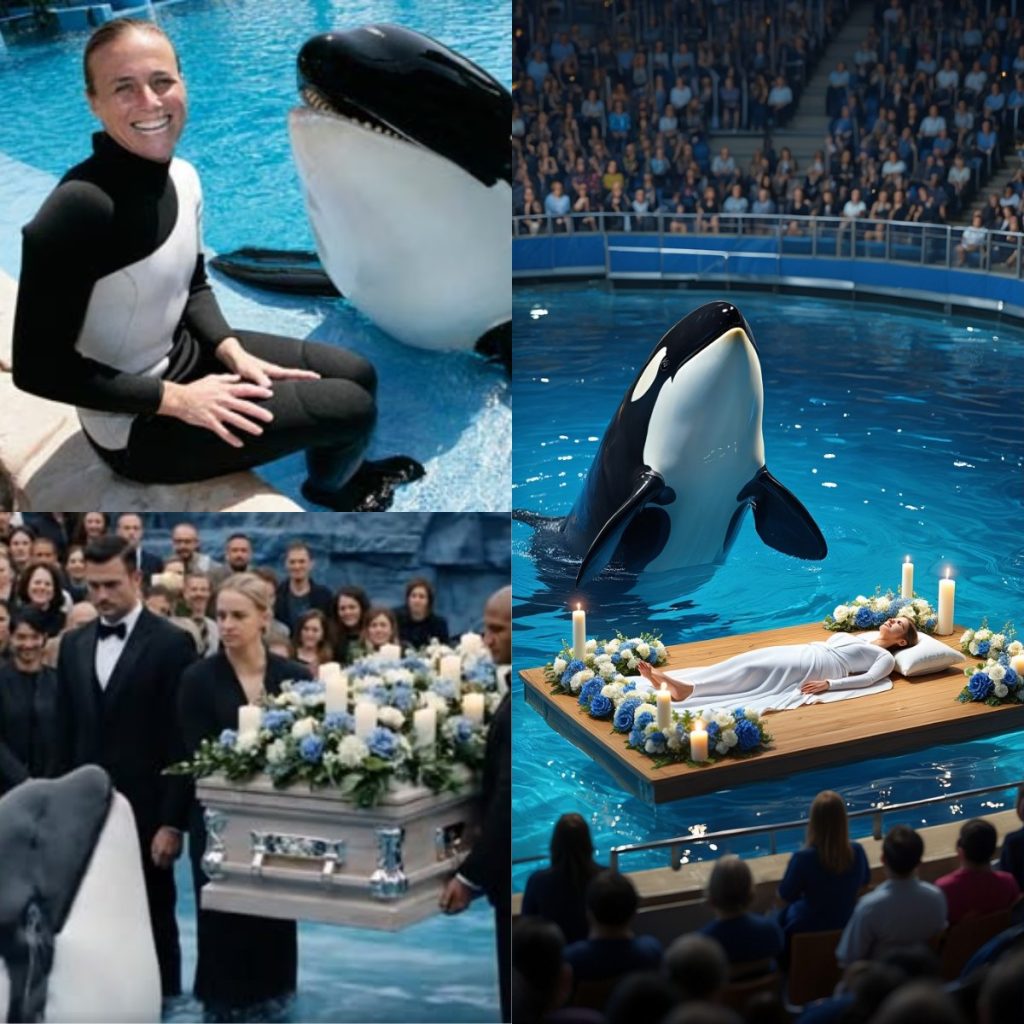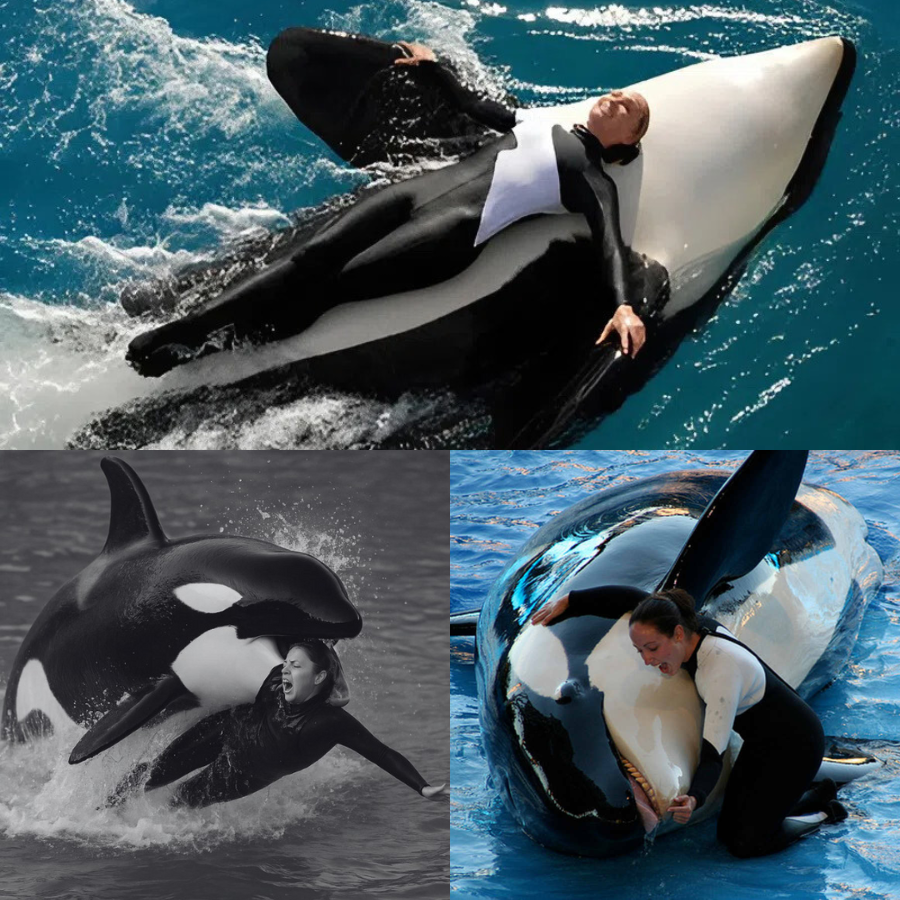
A Day That Began Like Any Other
It was supposed to be a normal afternoon show at OceanWorld Marine Park, where families gathered to marvel at the power and intelligence of orcas. Children cheered, tourists raised their phones to record, and trainers prepared for another breathtaking performance featuring one of the park’s most beloved orcas: Kai, a 6,000-pound male who had been performing for nearly a decade.
But in an instant, that joyful day turned into a nightmare. Before a stunned audience, Kai suddenly lunged at his longtime trainer and friend, dragging him underwater in a terrifying struggle that left spectators screaming. Panic swept through the stadium as staff scrambled to respond.
The question on everyone’s mind was simple: why? Why would an animal so familiar with humans, so seemingly bonded with his trainer, suddenly turn violent?
The Incident
According to eyewitnesses, the show was going smoothly. The trainer, identified only as Mark to protect his privacy, had guided Kai through a series of impressive jumps and synchronized movements. But when Mark attempted the finale — a moment where he rides on Kai’s back across the pool — the orca abruptly shifted.
Instead of allowing the trick, Kai flipped his body, knocking Mark into the water. What followed was a harrowing sequence: Kai grabbed hold of the trainer’s arm and pulled him under repeatedly, as if in a chilling reenactment of predator behavior.
Spectators screamed, some fainted, and security rushed to clear the area. Fellow trainers quickly deployed rescue measures, using signals and food distractions to force Kai to release Mark. After nearly two minutes of chaos, Mark was pulled to safety, injured but alive.
Immediate Aftermath
Mark was rushed to a local hospital with a dislocated shoulder, deep bite marks, and severe bruising. While doctors confirmed he was out of immediate danger, the psychological scars may prove more lasting than the physical ones.
In the hours that followed, the park canceled all remaining shows, while officials and animal behaviorists began to piece together what had gone wrong.

The Shocking Revelation
After an intense investigation involving marine biologists, veterinarians, and behavior experts, the park released its findings: Kai’s sudden attack was not the result of aggression or poor training. Instead, the incident was driven by stress, isolation, and frustration stemming from captivity itself.
Dr. Elena Ramirez, a marine behavior specialist brought in to review the case, explained:
“Orcas are highly intelligent, emotionally complex animals. Kai had been showing subtle signs of distress for weeks — reduced appetite, unusual swimming patterns, even changes in vocalizations. What happened wasn’t a random act of violence. It was a manifestation of long-term psychological strain.”
Signs That Were Missed
According to staff reports, Kai had been unusually restless in the days leading up to the incident. Trainers noted that he sometimes refused to perform certain tricks and displayed “surface-breaching” behaviors — loud, aggressive splashes often interpreted as expressions of agitation.
But with packed audiences and tight schedules, these warning signs were overlooked or underestimated.
“It’s easy to forget that these are wild animals, not circus performers,” said one anonymous trainer. “Sometimes, we get so focused on the show that we miss the signals they’re sending us.”
The Bond Between Trainer and Orca
Perhaps the most heartbreaking part of the story is the relationship between Mark and Kai. By all accounts, the two shared a close bond. Mark had worked with Kai since the orca’s early years, spending countless hours training, swimming, and even playing together.
In interviews prior to the incident, Mark often described Kai as “a best friend” and “a partner.” Their relationship was a testament to the deep connections that can form between humans and animals.
But as experts point out, even the strongest bonds cannot override the biological and emotional needs of such powerful creatures.
Public Outcry
The revelation of why Kai attacked has reignited fierce debate about the ethics of keeping orcas in captivity. Animal rights organizations seized on the incident as further evidence that marine parks should end such practices.
- PETA released a statement: “This tragedy is a reminder that orcas do not belong in tanks. Their aggression is not random — it’s the inevitable outcome of years of confinement and deprivation.”
- Hashtags like #FreeKai and #EndCaptivity began trending on social media, as fans expressed both relief that Mark survived and outrage at the conditions the orca endured.
The Park’s Dilemma
OceanWorld now finds itself at the center of a storm. On the one hand, Kai is a central attraction, beloved by fans and integral to the park’s revenue. On the other, the incident underscores the undeniable risks — both for trainers and for the orcas themselves.
The park announced it is reviewing whether Kai will ever perform again. For now, he remains in his tank, under close monitoring, while officials decide his future.
Broader Context: Orcas in Captivity
Kai’s case is not isolated. History records multiple instances of captive orcas displaying sudden aggression — from trainers being dragged underwater to fatal encounters. Scientists stress that in the wild, orcas rarely show aggression toward humans. Their violent behavior in captivity is often linked to stress, boredom, and the absence of natural social structures.
In the wild, orcas roam up to 100 miles a day and live in complex pods with rich social interactions. In captivity, they are confined to small tanks and separated from natural pod dynamics. This stark contrast is believed to be the root of their distress.
The Trainer’s Voice
From his hospital bed, Mark released a brief statement:
“I don’t blame Kai. I love him. He’s not a monster. He’s a magnificent animal who deserves more than what we can give him here. What happened was tragic, but I hope it opens people’s eyes.”
His words struck a chord, adding weight to calls for reform in the way marine parks operate.
What Happens Next
The incident has already sparked government involvement. Lawmakers have called for stricter regulations on animal captivity, and some are pushing for legislation that would phase out orca performances altogether.
Meanwhile, petitions demanding Kai’s relocation to a seaside sanctuary have gained hundreds of thousands of signatures in just days.
Whether OceanWorld complies remains to be seen, but the pressure is mounting.

A Tragic Lesson
The surprising reason behind the attack — psychological distress from captivity — has transformed what might have been dismissed as a freak accident into a powerful symbol. For many, Kai’s story represents the cost of forcing wild creatures into human entertainment.
As experts emphasize, the incident is less about blame and more about awareness. It is a reminder of the delicate balance between human fascination with wildlife and the responsibility to treat animals with dignity and respect.
Conclusion
The shocking attack of Kai the orca on his beloved trainer has revealed a deeper truth: even the strongest bonds cannot erase the toll of captivity. What happened in that pool was not a random act of violence, but the anguished expression of a magnificent animal struggling against an unnatural life.
For Mark, for Kai, and for the millions who watched in horror, the incident is a turning point. It challenges society to rethink not only how we treat orcas, but how we approach the broader relationship between humans and the natural world.
As the debate rages on, one thing is clear: the world will never look at orca performances the same way again.
